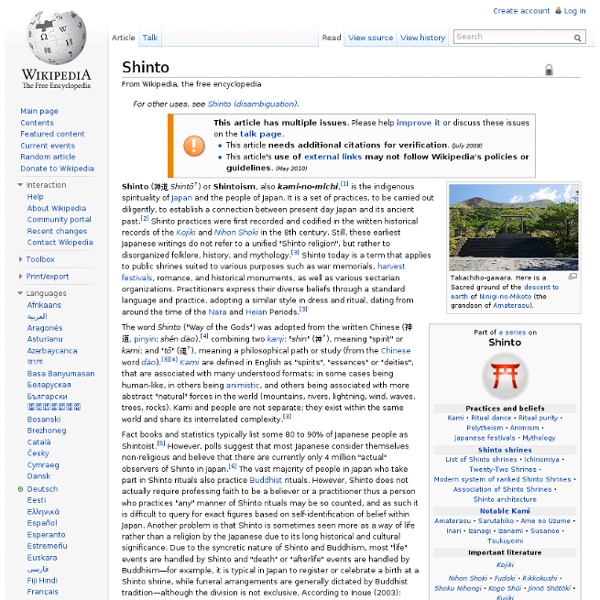Kojiki
Kojiki (古事記?, "Record of Ancient Matters") is the oldest extant chronicle in Japan, dating from the early 8th century (711–712) and composed by Ō no Yasumaro at the request of Empress Gemmei.[1] The Kojiki is a collection of myths concerning the origin of the four home islands of Japan, and the Kami. Along with the Nihon Shoki, the myths contained in the Kojiki are part of the inspiration behind Shinto practices and myths, including the misogi purification ritual.[2][3][4][5] Structure[edit] The Kojiki contains various songs/poems. While the historical records and myths are written in a form of Chinese with a heavy mixture of Japanese elements, the songs are written with Chinese characters that are only used to convey sounds.
Shikantaza
Shikantaza (只管打坐?) is a Japanese translation of a Chinese term for zazen introduced by Rujing, a monk of the Caodong school of Zen Buddhism. In Japan, it is associated with the Soto school. Etymology[edit] The term is believed to have been first used by Dōgen's teacher Tiantong Rujing, and it literally means, "nothing but (shikan) precisely (da) sitting (za)
Shintoshu
The Shintōshū (神道集?) is a Japanese story book in ten volumes believed to date from the Nanboku-chō period (1336–1392).[1] It illustrates with tales about various shrines the Buddhist honji suijaku theory, according to which Japanese kami were simply local manifestations of the Indian gods of Buddhism. This theory, created and developed mostly by Tendai monks, was never systematized, but was nonetheless very pervasive and very influential.[2] The book had thereafter great influence over literature and the arts.[1] History[edit] The book is believed to have been written during the late Nanboku-chō period, either during the Bunna or the Enbun era.[3] It carries the note Agui-saku (安居院作?
Kami
Amaterasu, one of the central kami in the Shinto faith Kami (Japanese: 神?) are the spirits or phenomena that are worshipped in the religion of Shinto.
Mahayana
Mahāyāna (Sanskrit: महायान mahāyāna, literally the "Great Vehicle") is one of two (or three, under some classifications) main existing branches of Buddhism and a term for classification of Buddhist philosophies and practice. The Buddhist tradition of Vajrayana is sometimes classified as a part of Mahayana Buddhism, but some scholars may consider it as a different branch altogether.[1] According to the teachings of Mahāyāna traditions, "Mahāyāna" also refers to the path of the Bodhisattva seeking complete enlightenment for the benefit of all sentient beings, also called "Bodhisattvayāna", or the "Bodhisattva Vehicle."[2][note 1] A bodhisattva who has accomplished this goal is called a samyaksaṃbuddha, or "fully enlightened Buddha." A samyaksaṃbuddha can establish the Dharma and lead disciples to enlightenment.
Japanese mythology
Japanese myths, as generally recognized in the mainstream today, are based on the Kojiki, the Nihon Shoki, and some complementary books. The Kojiki, or "Record of Ancient Matters", is the oldest surviving account of Japan's myths, legends and history. The Shintōshū describes the origins of Japanese deities from a Buddhist perspective, while the Hotsuma Tsutae records a substantially different version of the mythology.
In Praise of Shadows: Ancient Japanese Aesthetics and Why Every Technology Is a Technology of Thought – Brain Pickings
By Maria Popova At least since Plato’s Allegory of the Cave, we’ve seen shadows as a metaphor for the illusory and wicked aspects of life, for that which we must eradicate in order to illuminate the truth and inherent goodness of existence. And yet we forget that the darkness they cast evidences the light — palpable proof without which we might not appreciate or even notice the radiance itself. The 1933 gem In Praise of Shadows (public library) by Japanese literary titan Junichiro Tanizaki (July 24, 1886–July 30, 1965) belongs to that special order of slim, enormously powerful books that enchant the lay reader with an esoteric subject, leaving a lifelong imprint on the imagination — rare masterpieces like Robin Wall Kimmerer’s love letter to moss and Glenn Kurtz’s paean to the pleasures of playing guitar. Tanizaki, translated here by Thomas J. Harper and Edward G.
Wabi Sabi: An Unusual Children’s Book Based on the Japanese Philosophy of Finding Beauty in Imperfection and Impermanence
Wabi sabi is a beautiful Japanese concept that has no direct translation in English. Both an aesthetic and a worldview, it connotes a way of living that finds beauty in imperfection and accepts the natural cycle of growth and decay. Wabi Sabi is also the title of a fantastic 2008 picture-book by Mark Reibstein, with original artwork by acclaimed Chinese children’s book illustrator Ed Young, exploring this wonderful sensibility through the story of a cat who gets lost in her hometown of Kyoto only to find herself in the process. (For, lest we forget, we only find ourselves by getting lost.) The book reads like a scroll, from top to bottom, and features a haiku and a Japanese verse on each spread, adorned with Young’s beautifully textured artwork.



